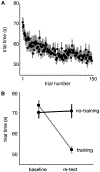Declines in motor transfer following upper extremity task-specific training in older adults
- PMID: 30562555
- PMCID: PMC6339591
- DOI: 10.1016/j.exger.2018.12.012
Declines in motor transfer following upper extremity task-specific training in older adults
Abstract
Background: Age-related declines in function can limit older adults' independence with activities of daily living (ADLs). While task-specific training maybe a viable approach to improve function, limited clinical resources prevent extensive training on wide ranges of skills and contexts. Thus, training on one task for the benefit of another (i.e., transfer) is important in geriatric physical rehabilitation. The purpose of this study was to test whether motor transfer would occur between two functionally different upper extremity tasks that simulate ADLs in a sample of older adults following task-specific training.
Methods: Ninety community dwelling adults ages 43 to 94 years old performed two trials of a functional dexterity and functional reaching task at baseline, and were then assigned to one of two groups. The training group completed 3 days of task-specific training (150 trials) on the functional reaching task, whereas the no-training group received no training on either task. Both groups were re-tested on both tasks at the end of Day 3.
Results: No significant interactions were observed between group (training vs. no-training) and time (baseline vs. re-test) on the functional dexterity task (i.e. transfer task), indicating no difference in the average amount of change from baseline to re-test between the groups. However, post hoc bivariate linear regression revealed an effect of age on motor transfer within the training group. For those who trained on the functional reaching task, the amount of transfer to the dexterity task was inversely related to age. There was no significant relationship between age and motor transfer for the no-training group.
Discussion and conclusions: Results of our a priori group analysis suggest that functional reaching training did not, on average, transfer to the dexterity task. However, post hoc regression analysis showed that motor transfer was both experience- and age-dependent, such that motor transfer may decline with advanced age. Future research will consider how functional and cognitive aging influences transfer of motor skills across different activities of daily living.
Keywords: Activities of daily living (ADLs); Aging; Functional training; Generalization; Motor learning; Rehabilitation.
Copyright © 2018 Elsevier Inc. All rights reserved.
Conflict of interest statement
Figures




References
-
- Andrews AW, Thomas MW, & Bohannon RW (1996). Normative values for isometric muscle force measurements obtained with hand-held dynamometers. Phys Ther, 76(3), 248–259. - PubMed
-
- Backman C, Mackie H, & Harris J (1991). Arthritis hand function test: Development of a standardized assessment tool. Occupational Therapy Journal of Research, 11, 245–256.
-
- Berghuis KMM, Semmler JG, Opie GM, Post AK, & Hortobágyi T (2017). Age-related changes in corticospinal excitability and intracortical inhibition after upper extremity motor learning: a systematic review and meta-analysis. Neurobiol Aging, 55, 61–71. doi:10.1016/j.neurobiolaging.2017.03.024 - DOI - PubMed
Publication types
MeSH terms
Grants and funding
LinkOut - more resources
Full Text Sources
Medical

